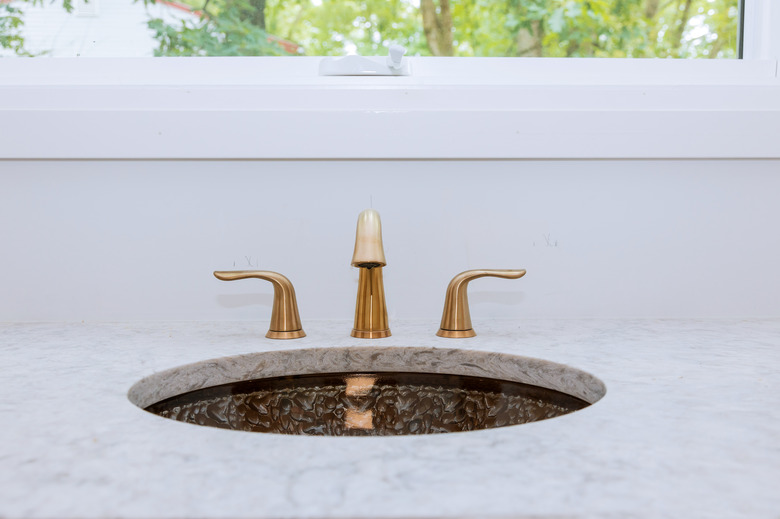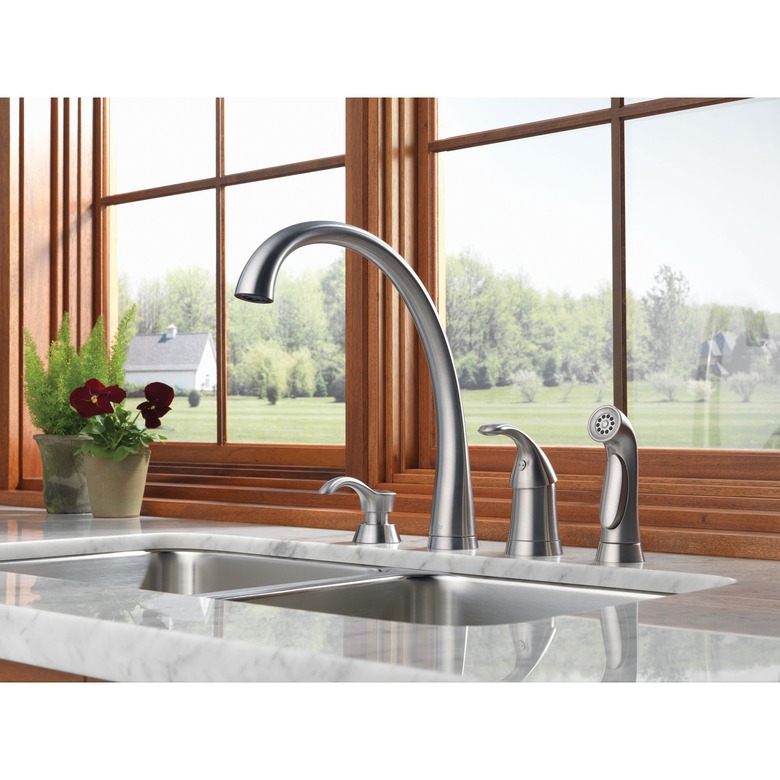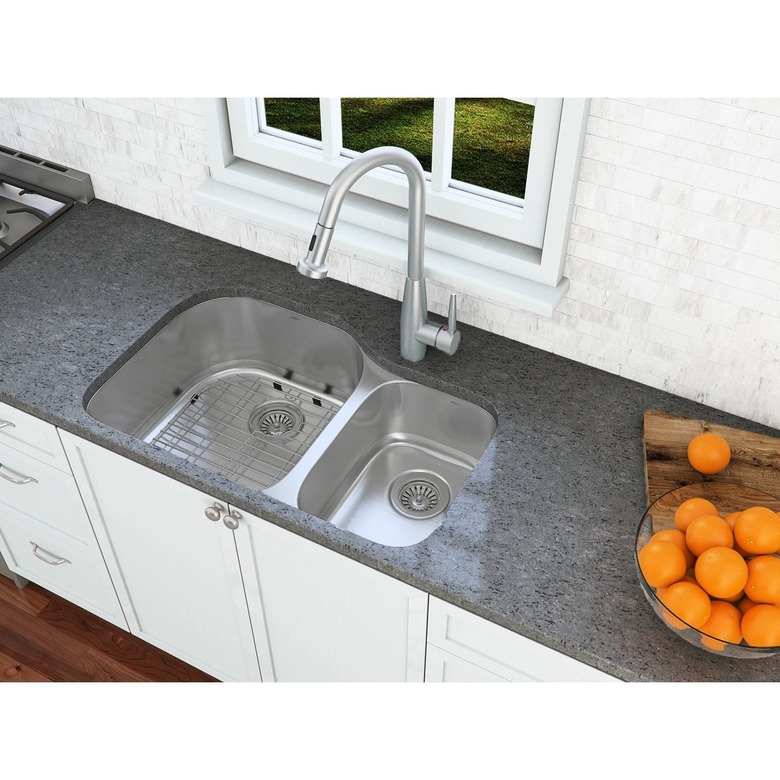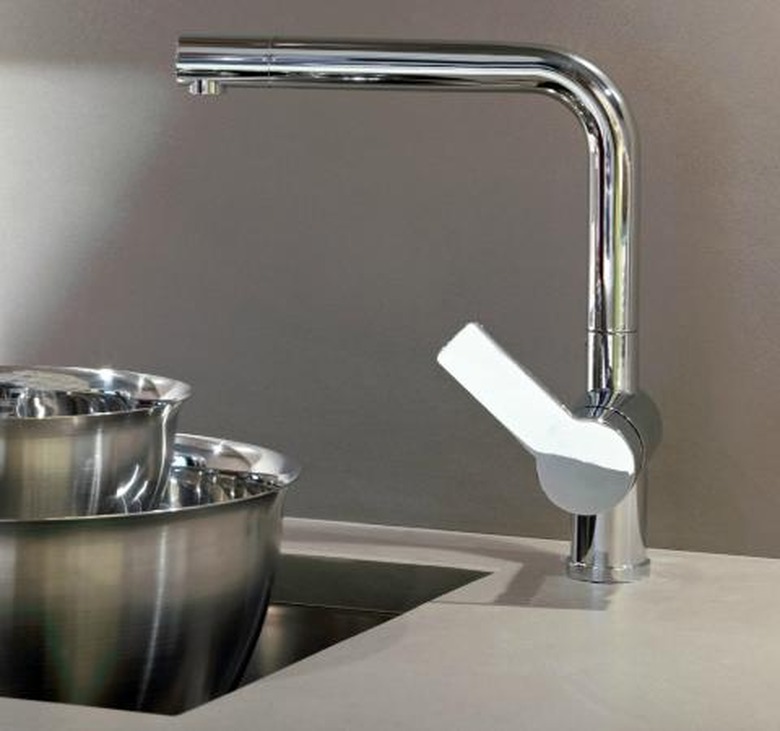How To Position Faucets With Undermount Sinks
Unlike other sink types, where the rim of the fixture includes pre-drilled faucet holes, there is no accessible rim on an undermount sink, which means you have to drill holes for the faucet in the countertop. The number and placement of these holes depends on the type of faucet you have, as well as on all the accessories you plan to install along with it. When a countertop comes with a premounted undermount sink—as is the case with many bathroom vanities—the faucet holes may already be bored, but with many countertops you will need to determine the best locations for the faucet and drill the holes yourself.
You may have chosen an undermount sink for the sophisticated simplicity it confers, and symmetry is the key to sophistication when measuring and marking the positions for the holes to accommodate the faucet and accessories. However, the realities of available space, sink dimensions and faucet construction may intervene to force an asymmetrical approach. Never fear...asymmetry has its own appeal. The important thing is to make sure the faucet directs water where you need it and isn't crowded or set too close to the backsplash to prevent you from turning the handle.
How Many Holes Do You Need?
How Many Holes Do You Need?
Your faucet may need one, two or three holes, depending on the style. Single-handle faucets frequently require only a single hole, while bridge-style faucets require two holes, and traditional double-handle faucets often call for three. When more than one hole is required, you'll find the required hole spacing in the product specifications, or you can measure the distance between faucet's tailpieces yourself. It's typically 4 inches between handles or between the spout and the handle for bathroom faucets and 8 inches for kitchen fixtures.
Tip
When measuring the spacing between faucet tailpieces or between holes in the countertop, the correct measurement is always "on-center"— from the center of one tailpiece or hole to the center of another.
In addition to holes for the faucet, you may need holes for one or more of the following accessories:
- Side sprayer
- Soap dispenser
- Water purifier
- Hot water dispenser
In addition, you may need an air gap for the dishwasher, if you live in a state that requires one. An air gap is a dome-shaped valve that sits on the countertop and connects to the dishwasher drain hose. Its purpose is to prevents waste water from flowing backwards into the dishwasher by preventing suction from develping in the drain hoses. If you're not sure whether you need one, check with your local plumbing code and building requirements.
The spacing of accessories relative to the faucet is more or less optional. They can be close together, as long as they aren't crowding each other, or far apart. When lining them up behind a sink, however, it's best to keep them within the space defined by the edges of the sink; otherwise, the countertop will look chaotic and you'll lose working space.
The Faucet Is Usually Centered Behind the Sink
The Faucet Is Usually Centered Behind the Sink
The most common placement for the faucet is directly behind the sink, centered midway between the sides. The distance between the faucet holes and the edge of the sink depends on the faucet style and should be such that the spout completely clears the edge of the sink. You'll usually find the setback distance, which is typically from 2 to 4 inches, listed in the product specifications. Keep in mind that the faucet connectors under the countertop have to clear the base of the sink. When the sink is square or rectangular, a lack of clearance often precludes placing the faucet any closer than the prescribed setback distance.
If you want to center a two-hole bridge faucet, measure the distance between the tailpieces and make a mark for each hole on the countertop, equal to half that distance from the center of the sink. When installing a three-hole faucet, mark the center hole, then measure the distance to each of the other two and mark them, using a ruler to align the holes parallel to the sink. Remember, the marks you're making denote the center of each hole and should correspond to the centers of the faucet tailpieces.
Some Situations Call for Offset Placement
Some Situations Call for Offset Placement
In at least four situations, the standard faucet placement is either undesirable or impossible:
- There isn't enough space. The sink is wide and the area between the sink and the backsplash is too small for the faucet. Alternatively, something under the sink is in the way.
- The sink isn't a regular shape. Not all sinks are oval or rectangular. Moreover, the basins on some double-basin sinks are different sizes, and placing the faucet in the middle of the sink makes no sense.
- The décor calls for an offset position. The kitchen or bathroom may have an unusual design that is better complemented by a quirky faucet placement.
- You want the faucet to be more accessible. You may want to place the faucet on the side of the sink instead of at the back so you can swivel it and fill a pot resting on the countertop.
There's no problem with locating the faucet anywhere around the sink, provided all these conditions are fulfilled:
- The spout completely overhangs the sink.
- Nothing interferes with the operation of the handle.
- The spout can swivel freely, if it's that type of faucet.
- There are no obstructions that prevent you from hooking up the faucet to the water supply.
When installing a two- or three-hole faucet, the line joining the holes should be oriented to the sink in a way that makes sense. If the sink is square or rectangular, the line of the faucet holes is usually parallel to one side. If the sink is round, oval or some other curved shape, consider drawing a tangent line on the curve at the point that corresponds to the center of the faucet and making the line that joins the holes parallel to that tangent.
Tip
A tangent is a line that touches a curve at only one point. A tangent is perpendicular to the line that extends from the center of the curve to that point. A good way to draw a tangent at a particular point on a curve is to place the short side of a combination square on the point, orient the square so the long side extends toward the center of the curve and draw the tangent along the short side of the square. This tangent then gives you a reference for lining up the faucet holes.
Faucet and Accessory Placement Can Be Creative
Faucet and Accessory Placement Can Be Creative
Each faucet and sink board accessory that requires a hole has its own clearance requirements. Most accessory clearances are the same as that of the faucet, meaning you can mount them the same distance from the sink. If the sink is square or rectangular, it's best for all the accessory holes to fall on single line parallel to the edge of the sink that includes the faucet holes. If the sink is round, oval or some other shape, you may want to distribute the holes around the sink perimeter at equal distances from the edge.
The rules of accessory placement are flexible and offer a lot of room for creativity. You can drill all the accessory holes on one side of the faucet, or you can arrange them on both sides. You can space them equally or not, depending on what works best with the room design. You may want to arrange them in conjunction with another feature, such as a rack or a shelf. Just remember to place the holes in a way that allows enough clearance to install the accessories and use them.



